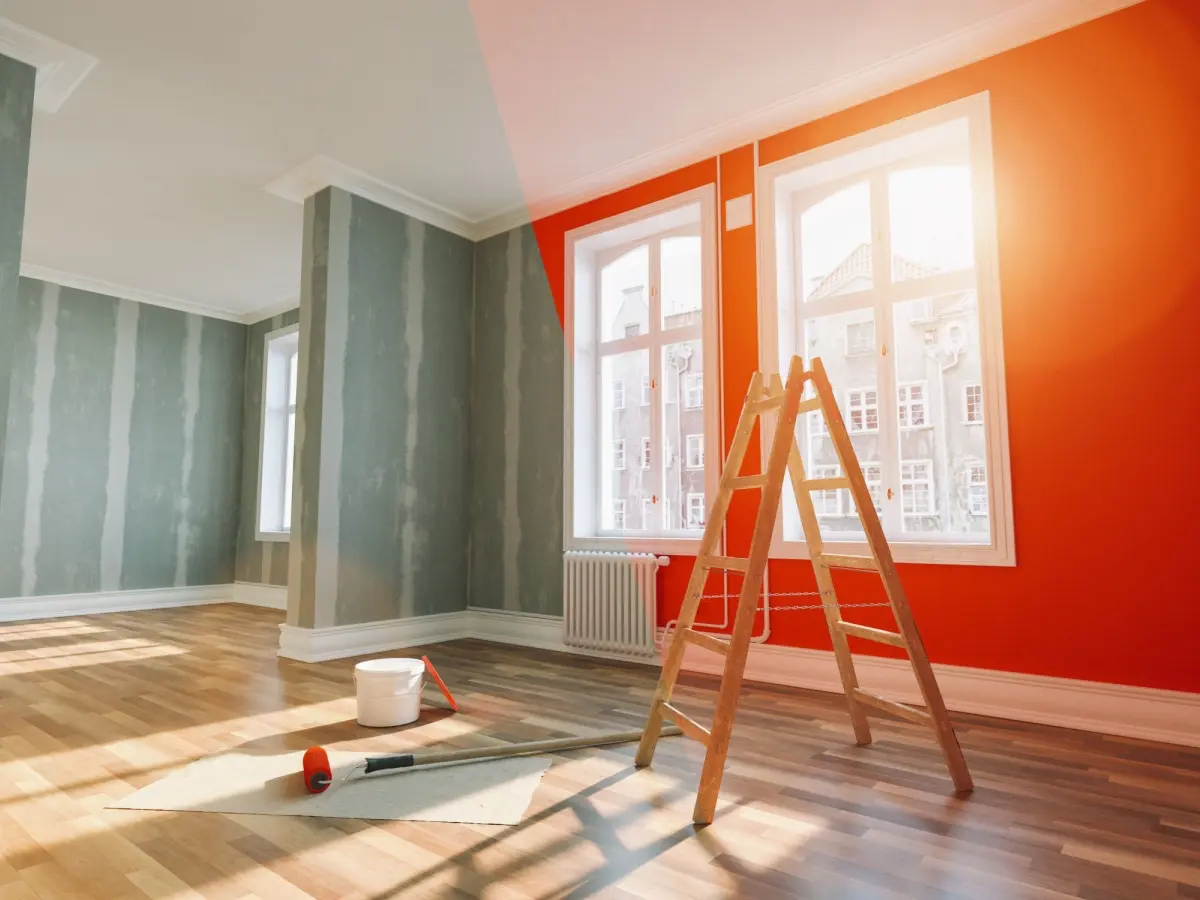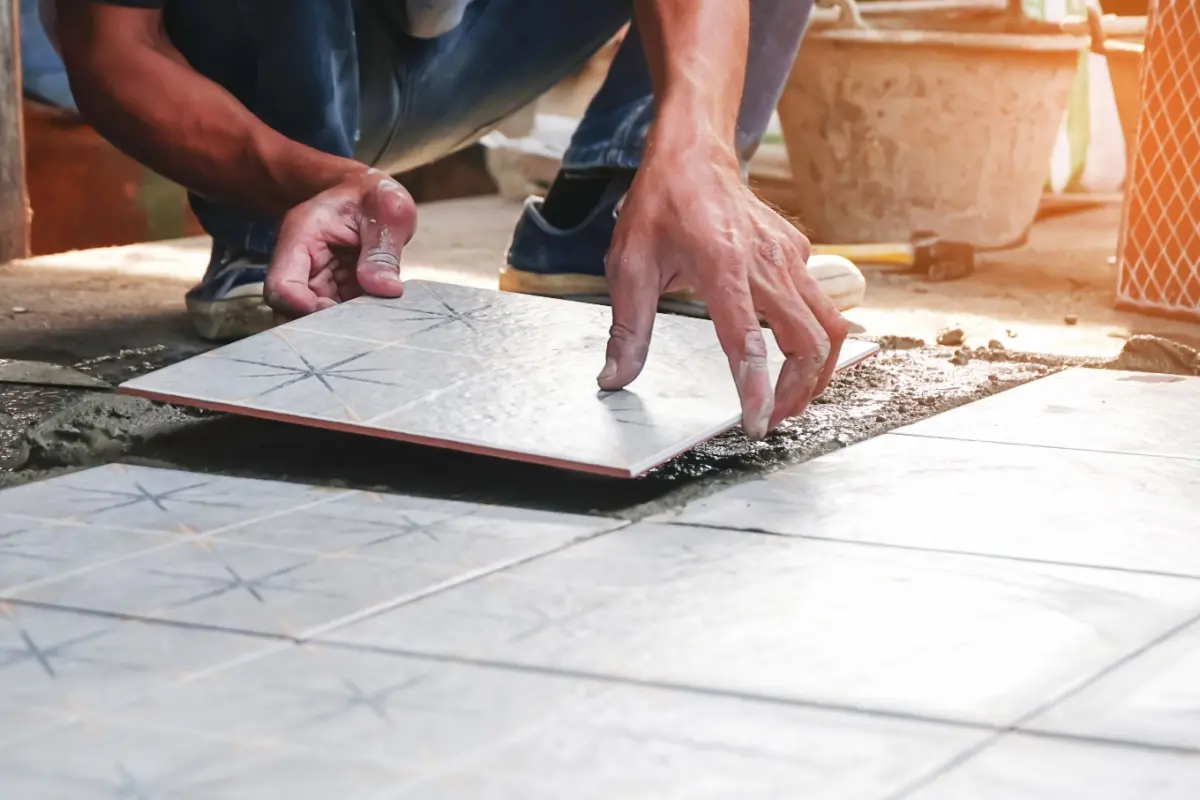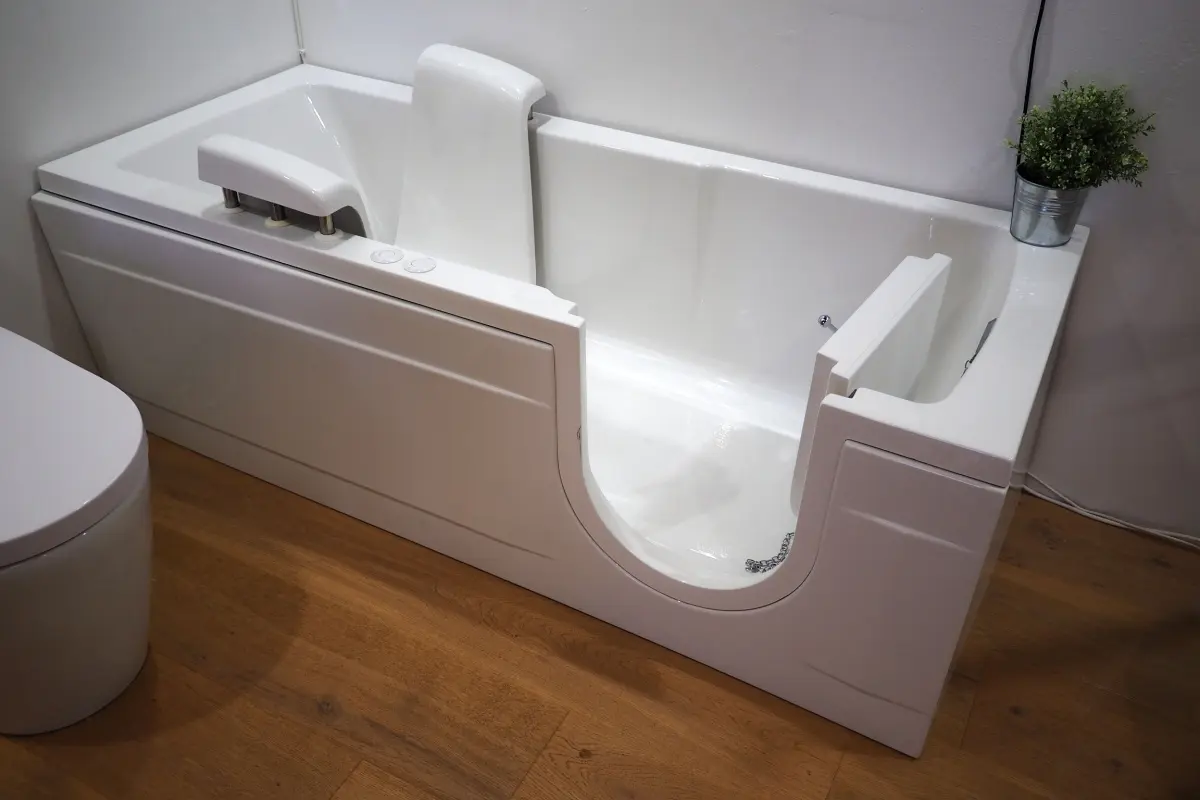Last spring, I caught the home improvement bug. After spending hours within the same four walls, I finally decided to transform my outdated living room into a cozy, functional space — and maybe increase my home’s value in the process. I know I’m not alone in wanting to upgrade my home.
Many homeowners recognize that investing in home remodeling projects boosts their property value and enhances their quality of life. They’re working from home now more than ever before, and rising housing costs are forcing people to stay put and work with what they have. In fact, 44% of homeowners completed a home maintenance project in 2024, and 80% of them hired a professional to do it. This is good news for home improvement businesses looking to expand.

Business growth in the home improvement industry requires understanding home renovation trends and the opportunities they present for your company. We’ve compiled trends, analysis, and outlook data below.
Home Improvement Industry Size
- The U.S. home improvement market has increased by 70% over the last 10 years, reaching $522.25 billion in 2023.
- The market is forecasted to hit $615.58 billion by 2029, an annual growth rate (CAGR) of 2.8%.
- Interior room remodels were the most popular type of renovation in 2023, with about 70% of Americans starting a project that year. Roughly 64% of homeowners embarked on home system updates, and 53% upgraded the exterior of the home.
8 Home Improvement Industry Trends
Today’s home improvement trends aren’t what they used to be. Consumer demands constantly change, pushing the industry to change right along with them. Below are the most significant home renovation industry trends to consider when brainstorming ways to make your business more competitive.
1. Kitchen and Bathroom Updates
→ Top trends: Layout modifications, energy-efficient systems and appliances, spa-like retreats and upgrades
Kitchens and bathrooms consistently top the list of the most popular renovation projects. Spending in these areas of the home hit record highs in 2023, and despite a slight 3% dip in 2024, homeowners still spent a whopping $173 billion on these projects.
The reason? People want modern, open-concept kitchens they can live in realistically. Plus, newly renovated kitchens and bathrooms are usually the most effective way to increase property value.
Home improvement contractors should expect to field requests for energy-efficient appliances like smart refrigerators, induction cooktops, and high-efficiency dishwashers, which have dominated the market.

Modern bathrooms are transforming into spa-like retreats. Features like rainfall showers, soaking tubs, heated floors, and advanced ventilation systems help homeowners create luxurious and comfortable spaces. Sustainable materials such as low-flow toilets, eco-friendly tiles, and reclaimed wood cabinetry are also popular, catering to environmentally-conscious consumers.
2. Smart Home Technologies
→ Top trends: Home security systems, centralized voice technology, smart appliances
Approximately 47.4 million U.S. households use smart home technologies. By 2025, experts predict that number to reach 77 million. These technologies meet the growing consumer demand for convenience and control. Centralized voice assistant technology and systems like Amazon Alexa, Google Home, and Apple Homekit allow homeowners to manage lighting, climate, and appliances through voice commands or mobile apps.
In addition, smart sensors can detect cigarette smoke in apartments, providing real-time alerts to property managers when unauthorized smoking occurs.

Now, refrigerators have internal cameras that can notify you when you’re running low on milk. Ovens can be preheated remotely, and washing machines can send alerts when a cycle is complete. These innovations save time and streamline household chores, making daily routines more efficient.
This trend is especially prominent in home security, as advancements now include remote smart locks, video doorbells with real-time footage, and motion sensors and alerts users can monitor from anywhere.
3. Sustainability and Energy Efficiency
→ Top trends: Reusable and/or green materials, smart thermostats, solar energy
Homeowners are prioritizing energy-efficient renovations to create sustainable and cost-effective homes. They’re increasingly investing in eco-friendly upgrades to reduce their carbon footprint and save money. Upgrades like installing energy-efficient windows, replacing insulation, and adding ENERGY STAR-certified appliances can reduce utility bills by about 20%. Plus, government incentives make leveraging renewable energy sources like solar panels more accessible and cost-effective.
Home improvement businesses should also know that this shift towards sustainability is influencing material choices in renovations, and companies should educate themselves accordingly. Many people are purchasing sustainable materials like bamboo flooring, recycled steel, and low-VOC (volatile organic compounds) paints. The emphasis on eco-friendly materials benefits the environment, improves air quality, and can increase property value by as much as 25%.
4. Home Office Renovations
→ Top trends: Ergonomic furnishes, upgraded lighting, soundproofing
These days, home offices cannot be an afterthought. As of 2023, more than 4.7 million Americans worked a hybrid or fully remote schedule, prompting them to create dedicated working spaces at home. Whether they convert their spare rooms and basements, or add more square footage to make room, these projects are becoming more popular and complex.
Modern home offices need upgraded furniture and fixtures, such as ergonomic desks and supportive chairs, but they also require systems upgrades. You might need to tackle electrical projects to add proper lighting, more power outlets, and WiFi connections. Soundproofing has also become popular, helping minimize household noises and creating a more professional environment for video meetings.
5. Aging-in-Place Modifications
→ Top trends: Accessible bathrooms, kitchens, and bedrooms, accessibility consulting and education
Experts estimate that only 10% of American homes are “aging ready,” which includes a step-free entryway, a first-floor bedroom and bathroom, and at least one bathroom accessibility feature. As the over-65 population increases rapidly, more older adults and their families are modifying their homes to allow them to live comfortably and safely in their homes as they age.

These projects can be as simple as installing grab bars in bathrooms and hallways or adding a stair lift to navigate multi-level residencies to more comprehensive upgrades like widening hallways and lowering thresholds throughout the property to reduce fall hazards.
This niche market is fostering innovation in home design, emphasizing universal design principles that ensure homes are adaptable for all ages and abilities. As a result, home improvement contractors have begun to consult aging-in-place specialists during the project who can help design accessible homes and identify areas of concern. Establishing relationships with mobility suppliers is also wise.
6. Outdoor Living Spaces
→ Top trends: Custom decks, outdoor kitchens, expansive gardens
As homeowners make the most of what they have, many are finding ways to expand their functioning living areas outside. Basic backyards are long gone, replaced by areas that cater to relaxation, entertainment, and family activities. Custom decks and patios, thoughtfully designed gardens, water features, and even unique garage doors are transforming how people use their outdoor areas.
Companies should prepare to answer the call for professionals skilled in outdoor construction and knowledge of weather-resistant materials and outdoor technologies. Projects like outdoor kitchens that include grills, sinks, and refrigerators can get complex, while patios and decks with fire pits require input from several tradespeople to complete the renovation.
7. Wellness Design
→ Top trends: Air quality systems, water purification, natural lighting elements
Wellness architecture and design is a growing trend that revitalizes a home with healthy living features. Designs that promote health and well-being move beyond aesthetics and focus on features that promote comfort and mental wellness, such as air quality systems, water filtration devices, natural lighting, and the use of non-toxic and sustainable materials.
These remodelings reduce indoor pollutants and allergens through advanced ventilation, filtration, and purification. Additionally, incorporating more natural lighting solutions, such as large windows and skylights, improves sleep patterns, boosts mood, and increases productivity.
8. Increase in Financing Options
→ Top trends: Pay over time, deferred billing, installment loans
Finally, the increase in diverse financing opportunities has lowered the barriers to home improvement, making it easier for homeowners to undertake upgrades. Many companies offer financing to customers in the form of installment loans and deferred billing. These options provide the necessary capital for both small-scale projects and extensive renovations, allowing homeowners to increase their living spaces without immediate financial strain.
Home Improvement Industry Analysis
As you consider home improvement trends, it’s also important to assess the factors that contribute to its potential growth (and decline). Let’s review the home improvement industry growth drivers, opportunities, and obstacles.
Home Improvement Market: Growth Drivers
Homeowners’ desire to invest in home improvement projects is driven by personal values and, most importantly, how well their homes fit their lifestyles. The three main growth drivers are as follows:
- Growing demand for custom personalization: Home is where the heart (and money) is. Today’s consumers want to customize their homes to fit their unique lifestyle and behavioral preferences. This includes tailored interior designs, fixtures, and spaces designed with intention. Outdoor living has become increasingly popular, driving much of the industry’s growth and demand.
- Preference for sustainable luxury: As consumer preferences shift toward sustainability and luxury, they are more likely to invest in projects that help them create environmentally-conscious living spaces. This can be a profitable niche for businesses willing to offer related services and expertise.
- Desire to own a home: A recent survey found that 70% of people believe owning a home is part of achieving the American dream. At the same time, new home builds continue to expand across the country. Whether people want to personalize a new home or upgrade an existing one, the preference for homeownership, and the growing number of people owning a home versus renting one, will continue to drive the home improvement market.
Home Improvement Market: Opportunities
Evolving consumer demands and market trends drive many opportunities for the home improvement sectors. Here’s how you can leverage industry shifts to grow your business more:
- Developing innovative solutions for small and compact living spaces can cater to the unique needs of urban living. This is driven by the rampant expansion we’ve seen in cities, which requires additional building and renovations to accommodate the growth.
- Providing energy-efficient solutions like solar panel installations, high-efficiency HVAC systems, and advanced insulation techniques can put your business in a position to offer a high-demand service — especially since homeowners can leverage available tax credits and rebates for energy-efficient renovations.
- Getting your business online opens a new channel for home improvement businesses and retailers, driving sales through targeted advertising and influencer partnerships. Explore e-commerce and digital platforms that enable you to sell products directly to consumers.
- Offering financing solutions for home renovations and remodeling can make renovations more accessible to your customers and drive more business, even when consumers feel hesitant to spend money during volatile economic conditions.
Home Improvement Market: Restraints and Challenges
While the home renovation industry has trended positively, it’s not immune from hardship. Homeowners want to revive their spaces but remain burdened by high upfront costs, making them nervous to make long-term commitments.
- Rising costs of goods and services: As material prices rise, so must your service pricing. Price hikes passed onto the consumer (through no fault of the business) make it harder for them to commit to the project. Bubbling lumber, steel, and paint prices are just some common building materials infected by inflation and renovation prices. For example, the average cost of a kitchen remodel increased by about 17% from 2020 to 2024, according to Remodeling Magazine.
- Breaks in the supply chain: The home improvement business is especially vulnerable to supply chain interruptions. The pandemic has disrupted the delivery routes of various materials, and the industry has yet to get back on its feet. Plus, high-demand green building materials like recycled steel, bamboo flooring, and low-VOC paints are often more expensive and less readily available than traditional alternatives.
- Consumer spending is down: There is a continued gap between real spending and real earnings, giving Americans lower disposable incomes and savings. As such, consumers can’t afford large upfront costs associated with home projects and could resort to DIY projects instead. This also supports the growing relevance of point of sale financing in the industry.
- Shortages of a skilled workforce: The current workforce is struggling to meet the growing demand for renovation projects because of a skilled labor shortage in the construction and renovation sectors. The industry now faces increased labor costs and longer project timelines, which can hinder the growth of the home improvement sector.
The Future of Home Improvement Industry
By now, it’s clear that the sector is experiencing growth and is on the brink of transformative changes. Experts predict the U.S. market will reach $615.58 billion by 2029, an annual growth rate (CAGR) of 2.8%.
At the same time, the U.S. green building materials market was estimated at $111.06 billion in 2023 and is predicted to hit $357.30 billion by 2033. This will largely be driven by the adoption of renewable energy sources, like solar panels and home battery systems, as well as biodegradable roofing materials and natural wood treatments and paints.
The burgeoning home industry market is enhancing property values and improving the quality of life for countless homeowners. With trends like smart home technology, sustainability, and the rise of outdoor living spaces shaping the market, home improvement’s future is exciting and promising.
FAQ
How Big Is the Home Improvement Industry?
The U.S. home improvement market has increased by 70% over the last 10 years, reaching $522.25 billion in 2023. Kitchen and bathroom remodels, as well as a growing demand for eco-friendly residential upgrades, are the biggest drivers of growth in the industry.
What Is the Most In-Demand Home Improvement Type?
General contracting, kitchen and bathroom remodeling, landscaping and outdoor living spaces, home energy, and home automation services are dominating the home improvement industry. A growing consumer demand for custom upgrades, paired with a skilled labor shortage for things like plumbing, welding, and roofing, represents a gap in the market and a business opportunity for people who want to start a home improvement business.
How Do Customers Choose the Right Contractor for a Home Renovation?
When selecting a contractor, customers prioritize proper licensing, insurance, and a strong reputation. They often review past projects and client feedback to gauge the contractor’s reliability and quality. Comparing quotes from multiple contractors is also a common practice, helping homeowners balance cost with the value of services provided.
What Are the Essential Tools for a Home Remodeling Project?
Key remodeling tools include a power drill, circular saw, measuring tape, level, utility knife, and a stud finder. Safety gear like gloves and goggles is also important. For more advanced tasks, tools like a nail gun, sander, or tile cutter may be needed depending on the project.


